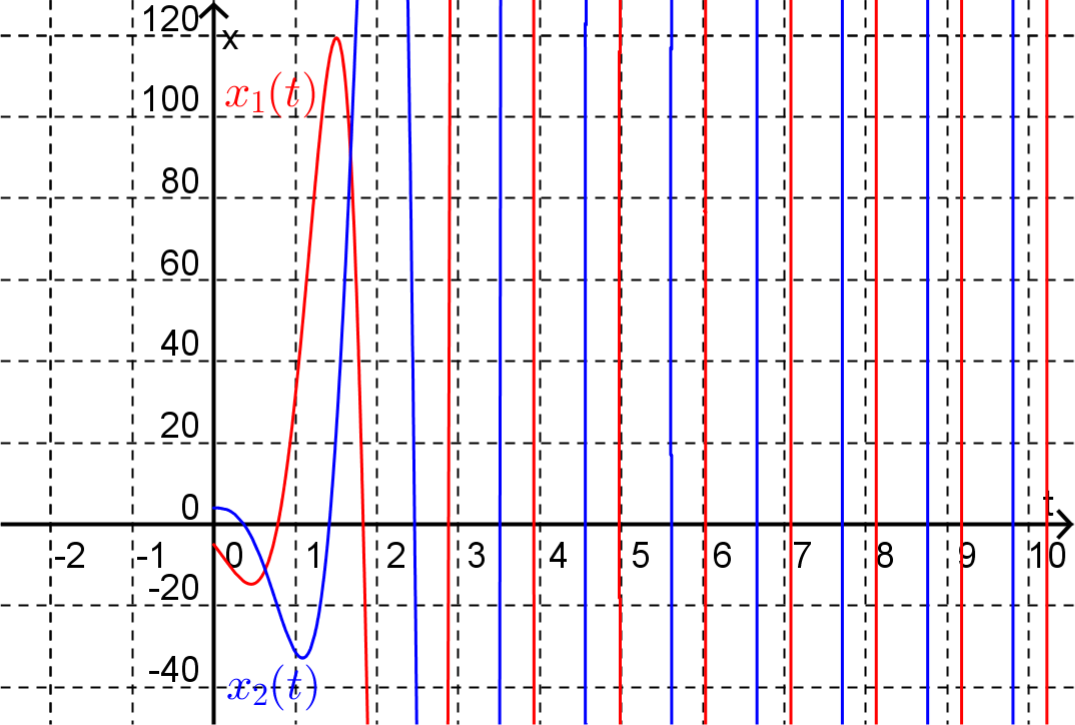Example 20.1.
Calculate \(A^3\) for
\begin{equation*}
A = \begin{pmatrix} 3 \amp 1 \\ 1 \amp 3 \end{pmatrix}\text{.}
\end{equation*}
Answer.
\(A^3 = \begin{pmatrix} 36 \amp 28 \\ 28 \amp 36 \end{pmatrix}\)
Solution.
Since \(n\) is small here it is easiest just to do the matrix multiplications to obtain
\begin{equation*}
A^3 = \begin{pmatrix} 3 \amp 1 \\ 1 \amp 3 \end{pmatrix} \begin{pmatrix} 3 \amp 1 \\ 1 \amp 3 \end{pmatrix} \begin{pmatrix} 3 \amp 1 \\ 1 \amp 3 \end{pmatrix} = \begin{pmatrix} 3 \amp 1 \\ 1 \amp 3 \end{pmatrix} \begin{pmatrix} 10 \amp 6 \\ 6 \amp 10 \end{pmatrix} = \begin{pmatrix} 36 \amp 28 \\ 28 \amp 36 \end{pmatrix}
\end{equation*}
However, let’s illustrate the above method (admittedly leaving out the working of finding eigenvalues, eigenvectors and matrix inverse). \(A\) has two distinct eigenvalues \(\lambda_1 = 2\) and \(\lambda_2 = 4\) with corresponding eigenvectors \(\mathbf{v}_1 = \begin{pmatrix} 1 \\ -1 \end{pmatrix}\) and \(\mathbf{v}_2 = \begin{pmatrix} 1 \\ 1 \end{pmatrix}\text{,}\) so let
\begin{equation*}
P = \begin{pmatrix} 1 \amp 1 \\ -1 \amp 1 \end{pmatrix}\text{.}
\end{equation*}
Thus
\begin{equation*}
P^{-1} = \dfrac{1}{2} \begin{pmatrix} 1 \amp -1 \\ 1 \amp 1 \end{pmatrix}
\end{equation*}
and therefore
\begin{align*}
A^3 \amp = PD^3 P^{-1}\\
\amp = \begin{pmatrix} 1 \amp 1 \\ -1 \amp 1 \end{pmatrix} \begin{pmatrix} 2^3 \amp 0 \\ 0 \amp 4^3 \end{pmatrix} \begin{pmatrix} 1/2 \amp -1/2 \\ 1/2 \amp 1/2 \end{pmatrix}\\
\amp = \begin{pmatrix} 1 \amp 1 \\ -1 \amp 1 \end{pmatrix} \begin{pmatrix} 4 \amp -4 \\ 32 \amp 32 \end{pmatrix}\\
\amp = \begin{pmatrix} 36 \amp 28 \\ 28 \amp 36 \end{pmatrix}
\end{align*}
As an aside, note that
\begin{align*}
P^{-1} AP \amp = \dfrac{1}{2} \begin{pmatrix} 1 \amp -1 \\ 1 \amp 1 \end{pmatrix} \begin{pmatrix} 3 \amp 1 \\ 1 \amp 3 \end{pmatrix} \begin{pmatrix} 1 \amp 1 \\ -1 \amp 1 \end{pmatrix}\\
\amp = \dfrac{1}{2} \begin{pmatrix} 1 \amp -1 \\ 1 \amp 1 \end{pmatrix} \begin{pmatrix} 2 \amp 4 \\ -2 \amp 4 \end{pmatrix}\\
\amp = \begin{pmatrix} 2 \amp 0 \\ 0 \amp 4 \end{pmatrix}
\end{align*}



